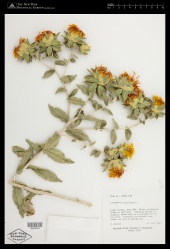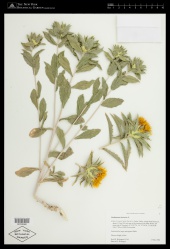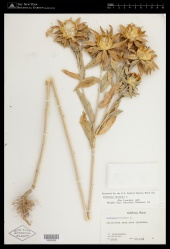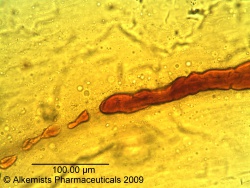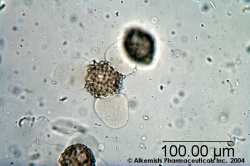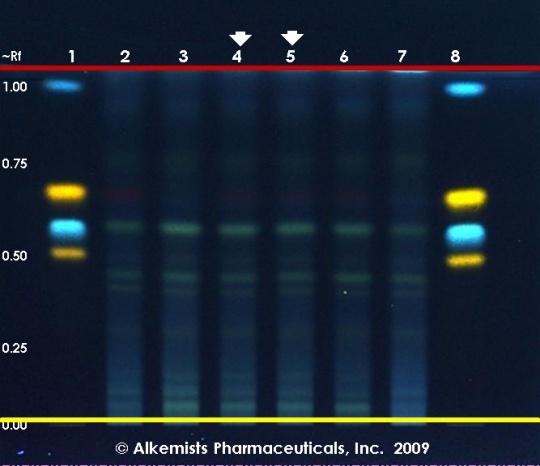Carthamus tinctorius (flower)
(→information from USD 1918) |
(add starr voucher specimens) |
||
| (7 intermediate revisions by 2 users not shown) | |||
| Line 1: | Line 1: | ||
| − | + | {{DISPLAYTITLE:''Carthamus tinctorius'' (flower) }} {{askbox|herb=''Carthamus tinctorius''}} | |
| − | + | =Nomenclature= | |
| − | {{ | + | {{nomenclature | binomial=Carthamus tinctorius |
| − | | | + | |authority=L. |
| − | + | |family=Asteraceae | |
| + | |scn=safflower | ||
| + | |syn= | ||
| + | |ayurvedic=kusumbha | ||
| + | |pinyin=hong hua (flower) | ||
| + | |aka= | ||
| + | |notes= }} | ||
| − | It contains a fixed oil; also two coloring substances—one red, insoluble in alkaline liquids, and called ''carthamin'' or ''carthamic acid'' by Dobereiner, who found it to possess weak acid properties; the other yellow, and soluble in water. | + | =Botanical Voucher Specimen= |
| + | {{Media3 |cat=Voucher | ||
| + | |companyimage=Starr herbarium logo.png | ||
| + | | companyURL=http://sciweb.nybg.org/science2/VirtualHerbarium.asp | ||
| + | |mainimage=Carthamus tinctorius L. - Starr - 00505324.jpg | ||
| + | |caption1=''Carthamus tinctorius'' L. | ||
| + | |source=Images courtesy of the C.V. Starr Virtual Herbarium of the New York Botanical Garden | ||
| + | |companyimage2=Starr herbarium logo.png | ||
| + | | companyURL2=http://sciweb.nybg.org/science2/VirtualHerbarium.asp | ||
| + | |image2=Carthamus tinctorius L. - Starr - 00703082.jpg | ||
| + | |caption2=''Carthamus tinctorius'' L. | ||
| + | |source2=Images courtesy of the C.V. Starr Virtual Herbarium of the New York Botanical Garden | ||
| + | |companyimage3=Starr herbarium logo.png | ||
| + | | companyURL3=http://sciweb.nybg.org/science2/VirtualHerbarium.asp | ||
| + | |image3=Carthamus tinctorius L. - Starr - 00505329.jpg | ||
| + | |caption3=''Carthamus tinctorius'' L. | ||
| + | |source3=Images courtesy of the C.V. Starr Virtual Herbarium of the New York Botanical Garden | ||
| + | |}} | ||
| + | =Organoleptic Characteristics= | ||
| + | {| border=1 | ||
| + | | | ||
| + | {{Organolepsy | source=United States Dispensatory (1918) | ||
| + | | description=''Carthamus tinctorius'' L. ''Safflower''.— [...] has a peculiar, slightly aromatic odor, and a scarcely perceptible bitterness. }} | ||
| + | |} | ||
| + | =Macroscopic Characteristics= | ||
| + | {| border=1 | ||
| + | | | ||
| + | {{Macroscopy | source=United States Dispensatory (1918) | ||
| + | | description=''Carthamus tinctorius'' L. ''Safflower''.— The African, false, American, or dyers' saffron is an annual composite, with a smooth, erect stem, somewhat branched at top, and a foot or two in height. [...] The florets are in mass of a red color, diversified by the yellow of the styles contained within the floret. [...] It contains a fixed oil; also two coloring substances—one red, insoluble in alkaline liquids, and called ''carthamin'' or ''carthamic acid'' by Dobereiner, who found it to possess weak acid properties; the other yellow, and soluble in water. | ||
}} | }} | ||
| + | |} | ||
| + | =Microscopic Characteristics= | ||
| − | + | {{Media2 |cat=Microscopy | source=Elan M. Sudberg, Alkemist Laboratories | |
| − | {{Microscopy | source=Elan M. Sudberg, Alkemist Laboratories | + | |
| companyimage= AP-LOGO-Laboratories Crop - Copy.jpg | | companyimage= AP-LOGO-Laboratories Crop - Copy.jpg | ||
| − | | companyURL=http://www. | + | | companyURL=http://www.alkemist.com |
| mainimage=Safflower Alkemist Laboratories.jpg | | mainimage=Safflower Alkemist Laboratories.jpg | ||
| caption1=Fragment of the corolla showing brown laticiferous vessels observed at 400x with Acidified Chloral Hydrate Glycerol Solution. | | caption1=Fragment of the corolla showing brown laticiferous vessels observed at 400x with Acidified Chloral Hydrate Glycerol Solution. | ||
| description= Safflower (flower) (''Carthamus tinctorius'') | | description= Safflower (flower) (''Carthamus tinctorius'') | ||
| + | | source2=Elan M. Sudberg, Alkemist Laboratories | ||
| + | | companyimage2= AP-LOGO-Laboratories Crop - Copy.jpg | ||
| + | | companyURL2=http://www.alkemist.com | ||
| image2=Safflower-1 Alkemist Laboratories.jpg | | image2=Safflower-1 Alkemist Laboratories.jpg | ||
| caption2=Three pored pollen grain shown exuding contents observed at 400x with Acidified Chloral Hydrate Glycerol Solution. | | caption2=Three pored pollen grain shown exuding contents observed at 400x with Acidified Chloral Hydrate Glycerol Solution. | ||
| Line 23: | Line 61: | ||
| − | = | + | =High Performance Thin Layer Chromatographic Identification= |
{{HPTLC | source=Elan M. Sudberg, Alkemist Laboratories | {{HPTLC | source=Elan M. Sudberg, Alkemist Laboratories | ||
| description=Safflower (flower) (''Carthamus tinctorius'') | | description=Safflower (flower) (''Carthamus tinctorius'') | ||
| Line 50: | Line 88: | ||
| − | = | + | =Supplementary Information= |
| − | + | =Sources= | |
| + | <references /> | ||
Latest revision as of 18:28, 21 July 2015
Contents |
Nomenclature
Carthamus tinctorius L. Asteraceae
Standardized common name (English): safflower
Ayurvedic name(s): kusumbha
Pinyin name(s): hong hua (flower)
Botanical Voucher Specimen
|
|
|
|
Organoleptic Characteristics
|
Macroscopic Characteristics
|
Microscopic Characteristics
 |
 |
|
|
|
High Performance Thin Layer Chromatographic Identification
|
Safflower (flower) (Carthamus tinctorius) Lane Assignments Lanes, from left to right (Track, Volume, Sample):
Reference materials used here have been authenticated by macroscopic, microscopic &/or TLC studies according to the reference source cited below held at Alkemists Laboratories, Costa Mesa, CA. Stationary Phase Silica gel 60, F254, 10 x 10 cm HPTLC plates Mobile Phase ethyl acetate: AcCOOH: HCOOH: H2O [10/1.1/1.1/2.4] Sample Preparation Method 0.3 g + 3 ml CH3OH sonicated + heated @ 50° C ~ 1 hr Detection Method Natural Product Reagent + PEG -> UV 365 nm Reference see Adapted from Plant Drug Analysis, Wagner, H., 1996
|
Supplementary Information
Sources
- ↑ Images courtesy of the C.V. Starr Virtual Herbarium of the New York Botanical Garden http://sciweb.nybg.org/science2/VirtualHerbarium.asp
- ↑ Images courtesy of the C.V. Starr Virtual Herbarium of the New York Botanical Garden http://sciweb.nybg.org/science2/VirtualHerbarium.asp
- ↑ Images courtesy of the C.V. Starr Virtual Herbarium of the New York Botanical Garden http://sciweb.nybg.org/science2/VirtualHerbarium.asp
- ↑ United States Dispensatory (1918)
- ↑ United States Dispensatory (1918)
- ↑ Elan M. Sudberg, Alkemist Laboratories http://www.alkemist.com
- ↑ Elan M. Sudberg, Alkemist Laboratories http://www.alkemist.com
- ↑ Elan M. Sudberg, Alkemist Laboratories http://www.alkemist.com
